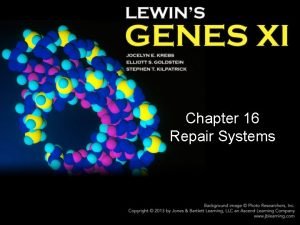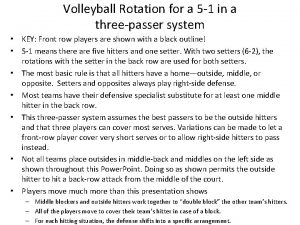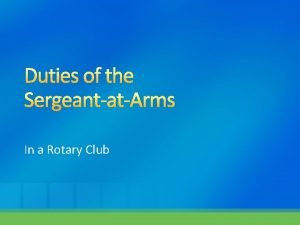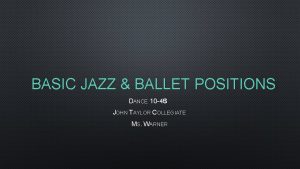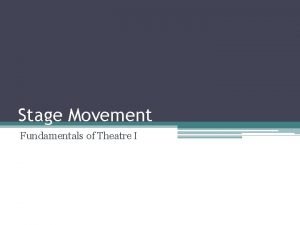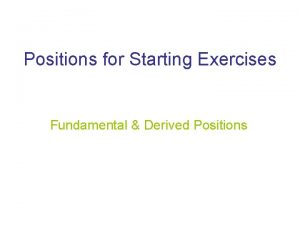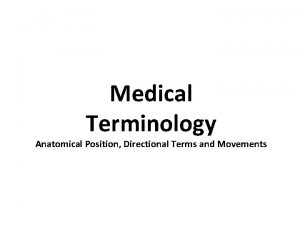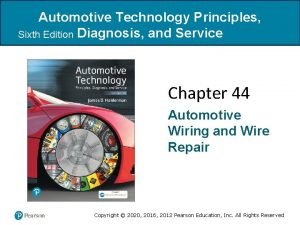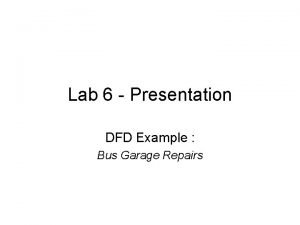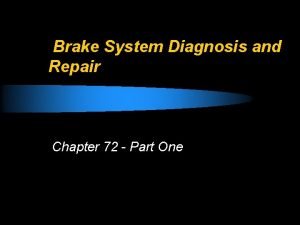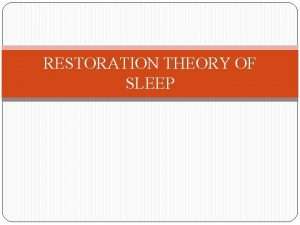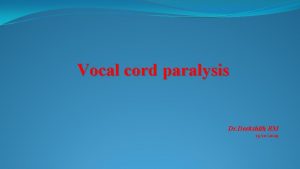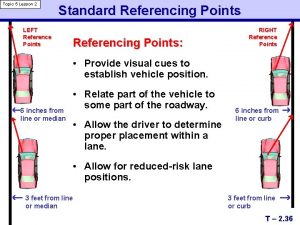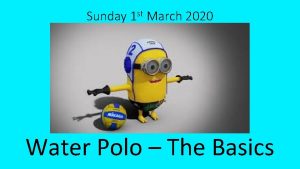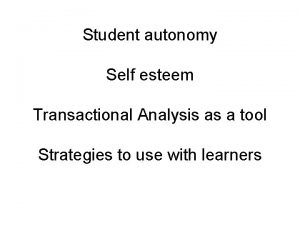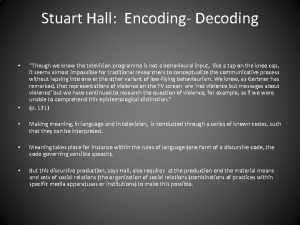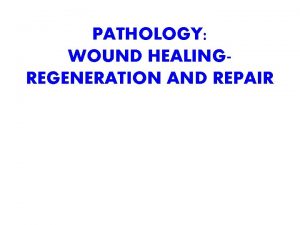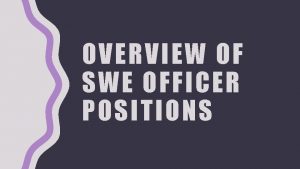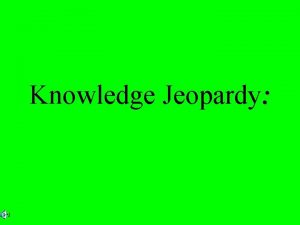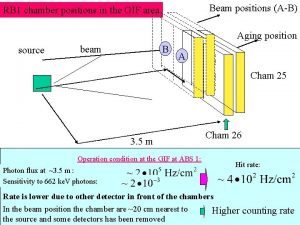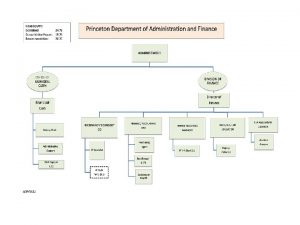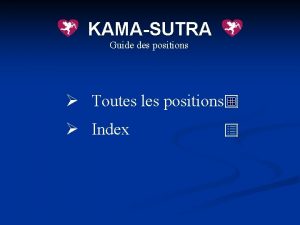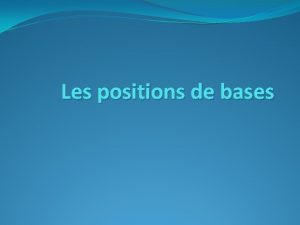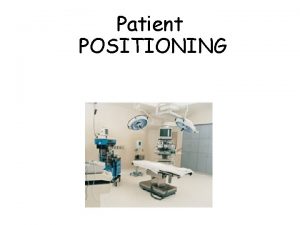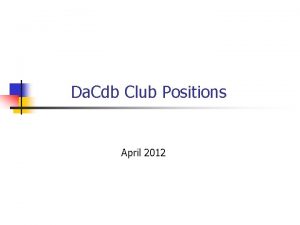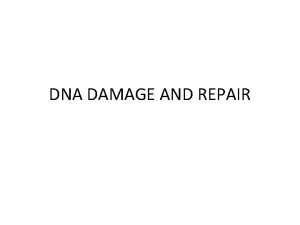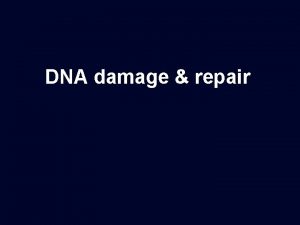Repair Types and positions Types of repair Repair







































- Slides: 39

Repair: Types and positions

Types of repair • Repair involves two important activities: – indicating that a repair is needed (repair initiation), and – making the repair (repair). • Each of these can be performed by different participants in the conversation. – Repair initiation can be done by : • the speaker of the repairable (self-initiated repair) • the recipient of the repairable (other-initiated repair) – Repair can be made by • the speaker of the repairable (self repair) • the recipient of the item (other repair)

Types of repair • There are four different types of repair: 1. 2. 3. 4. Self-initiated self repair: in which the speaker of the repairable item both indicates a problem in the talk and resolves the problem; Self-initiated other repair: in which the speaker of the repairable item indicates a problem in the talk, but the recipient resolves the problem; Other-initiated self repair: in which the recipient of the repairable item indicates a problem in the talk and the speaker resolves the problem; and Other-initiated other repair: in which the recipient of the repairable item both indicates a problem in the talk and resolves the problem.

Positions for repair • Repair can be found in may different sequential positions relative to the trouble: – within the same turn as the trouble source (same turn repair) – in the transition space following the turn containing the trouble source (transition space repair) – in the turn immediately following the trouble source (second position repair) – in a third positioned turn (third position repair) – in a fourth positioned turn. (fourth position repair)

Repair initiation and positions • Types of repair initiation are distributed across the positions in which repair can begin: same turn: self-initiation transition space: self-initiation second position: other-initiation third position: self-initiation fourth position: other-initiation

Examples of repair types and positions • Same turn: self-initiated self repair • Transition space: self-initiated self repair • Second position: other-initiated self repair

Examples of repair types and positions • Third position: self-initiated self repair • Fourth position: other-initiated self repair

Same turn repair • Same turn repair is accomplished by non-lexical perturbations in speech such as cut-offs, uh and uhm, pauses or sound stretches. • Cut-offs – Cut-offs are interruptions of the word (or sound) underway. – They works to stop the next due from being articulated. – They are used to initiate repair on some trouble source which has already been produced.

Same turn repair • Uh, uhm and pauses – These occur outside word boundaries and stop the articulation of the next word due in the turn. – They are typically used to repair a next element in the talk.

Same turn repair • Sound stretches – Sound stretches initiate a search for some unavailable item. – They are employed within a word, but serves to initiate repair of some next element.

Same turn repair • The various types of repair initiations are often found in combination as a repair segment.

Same turn repair • Self-initiated repair in the same turn is usually resolved by the speaker (self-initiated self repair). • It may be repaired by the recipient in a next turn (self-initiated other-repair).

Same turn repair • Same turn repair can deal with interactional problems resulting from actions of the recipient. – Recycled turn beginnings are closely linked to repairing problems of securing a gazing recipient.

Transition space repair • There a number of formats found in initiating transition space repair. – No explicit repair initiation marker. – A very reduced transition space (e. g. latching). – Devices such as uh and uhm

Transition space repair • There a number of formats found in initiating transition space repair. – Devices such as I mean. – A not X, Y format.

Second position repair • Second position repair is the first structurally specified place for other-initiated repair. • Many of other-initiated repairs are spread over two turns: – They are initiated in second position by the recipient of the trouble (FPP) – They are completed in third position by the speaker of the trouble (SPP).

Second position repair • Speakers use a range of turn-constructional devices to initiate repair in second position. – Repair initiators such as huh? or what?

Second position repair • Speakers use a range of turn-constructional devices to initiate repair in second position. – Specific question words such as who, where and when.

Second position repair • Speakers use a range of turn-constructional devices to initiate repair in second position. – Partial repeats with a question word.

Second position repair • Speakers use a range of turn-constructional devices to initiate repair in second position. – You mean with a possible understanding of the prior trouble.

Second position repair • Other-initiated other repair (correction) has distinctive formats. – Exposed correction: – This structure is: a. A speaker produces some object (X) b. A subsequent speaker produces an alternative (Y) c. The prior speaker produces the alternative (Y) (accepts correction).

Second position repair • Correction may be associated with other correction-related talk: warrants, explanations, etc. • Other repair may be rejected. – This means there is a variant for the final position in the structure: c’ The prior speaker produces the original (X) (rejects correction)

Second position repair • Embedded correction – The structure of embedded correction is like exposed correction, but correction talk is not the main activity happening. – Other correction related talk does not occur.

Third position repair • Third position allows for repairing a trouble in understanding of a prior turn demonstrated by the recipient’s response to it.

Third position repair • There is a four component format for third position repair, consisting of: – a repair-initiating component – an agreement/acceptance component – a rejection component – the repair proper

Third position repair • The repair-initiating component has the forms: – No. • No may be repeated as no no or no no no. • No may also be found in combination with oh. – Well

Third position repair • The agreement/acceptance component occurs where the original turn is treated as a complaint.

Third position repair • The rejection component rejects the understanding of the first turn revealed by the recipient’s response. – There a small number of possible formats • I don’t mean X. • I’m not X-ing format, where X names an action which prior speaker has understood the talk to be doing. • Combined formats with the action represented by a proform: that’s not what I mean, I don’t mean that.

Third position repair • I don’t mean X.

Third position repair • I’m not X-ing.

Third position repair • Combined format.

Third position repair • The repair proper modifies the prior turn in some way to deal with a problem. • There a small number of common formats: – The speaker may repeat the prior turn with some modification.

Third position repair • The repair proper modifies the prior turn in some way to deal with a problem. • There a small number of common formats: – I mean + repair.

Third position repair • The repair proper modifies the prior turn in some way to deal with a problem. • There a small number of common formats: – a more specific formulation of the trouble source.

Third position repair • The repair proper modifies the prior turn in some way to deal with a problem. • There a small number of common formats: – An explanation.

Third position repair • The repair proper modifies the prior turn in some way to deal with a problem. • There a small number of common formats: – a characterization of the trouble source as serious or non-serious.

Fourth position repair • Fourth position repair allows a recipient of a trouble to repair a problem of understanding evident in the talk produced in the third position. • Fourth position repair consists of two components. – a change of state token oh reflecting – a recharacterization of the trouble source.

The multiple repair space • The series of positions form a repair initiation opportunity space. Turn 1 Turn 2 A: B: Turn 3 A: Turn 4 B: Turn 5 A: Turn 6 B: 2 nd position repair on T 1 2 nd position repair on T 2 2 nd position repair on T 3 2 nd position repair on T 4 2 nd position repair on T 5 3 rd position repair on T 1 3 rd position repair on T 2 3 rd position repair on T 3 3 rd position repair on T 4 4 th position repair on T 1 4 th position repair on T 2 4 th position repair on T 3

The preference for self-repair • There is a preference for self-repair in conversation. • The preference does not affect who initiates repair but who does repair. – Self and other initiation are equally available to deal with problems. – Self repair is preferred and other repair is dispreferred.
 Excision repair
Excision repair Mismatch repair
Mismatch repair Position used in nursing patient
Position used in nursing patient Types of repair
Types of repair 5-1 rotations volleyball
5-1 rotations volleyball Rugby positions and numbers
Rugby positions and numbers Fundamental and derived positions
Fundamental and derived positions Sergeant at arms duties and responsibilities
Sergeant at arms duties and responsibilities Jazz positions of the feet and arms
Jazz positions of the feet and arms Lap weld symbol
Lap weld symbol Stage areas and body positions
Stage areas and body positions Fundamental starting position
Fundamental starting position Cengage chapter 4 answers
Cengage chapter 4 answers 5th position
5th position Medical term for right arm
Medical term for right arm Whats primase
Whats primase Power brake system
Power brake system Electronic suspension system
Electronic suspension system Peak and hold injector waveform
Peak and hold injector waveform Chapter 44 automotive wiring and wire repair
Chapter 44 automotive wiring and wire repair Bus garage repairs level 0
Bus garage repairs level 0 Faa 337 form
Faa 337 form Brake system diagnosis
Brake system diagnosis Auto upkeep answer key
Auto upkeep answer key Repair and restoration theory of sleep
Repair and restoration theory of sleep Repair renovation and restoration of water bodies
Repair renovation and restoration of water bodies Repair theory of sleep
Repair theory of sleep Compound welds
Compound welds Norman leighton
Norman leighton Vocal cord plication
Vocal cord plication To compromise space means to
To compromise space means to Bsa organization chart
Bsa organization chart Life positions in transactional analysis
Life positions in transactional analysis Visual reference point
Visual reference point Auguste escoffier brigade system
Auguste escoffier brigade system Water polo positions
Water polo positions What is burking suffocation
What is burking suffocation Life positions in transactional analysis
Life positions in transactional analysis Stuart hall reading positions
Stuart hall reading positions It is the position of the acting area about the audience
It is the position of the acting area about the audience

